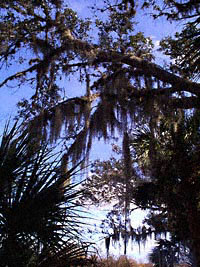Mosquito
Island, The
Death of the Pines
Some
people also know Mosquito Island by the name of "Christmas
Tree", but the Australian pines that gave it
that name are totally dead now, so that name just doesn't
work anymore.

A few short months made quite
a difference.
 |
We ran
into a bunch of hunters on the island one day, and someone
said that they had heard that the Water Management had
sprayed them intentionally. That seemed rather strange,
as the trees had been there forever and were a familiar
stopping place to everyone. Most trees on the marsh are
low, bushy things like Myrtle and Willow, so the tall Pine
trees were one of the few landmarks that could be seen
for a long ways.
Well, inquiring
minds want to know, so I wrote to the St.
Johns River Water Management District and asked.
I got a very prompt and friendly response telling me the
trees were indeed sprayed by them. Believe it or not,
Australian Pines are considered a "category 1 invasive
pest plant". Category 1 are those plants that "pose
the greatest threat to the natural environment".
Who knew!? Public land managers
are required to control "exotic invasive plants" and
maintain the environment in its natural state. Apparently
their job performance is graded on how well they perform
this duty, therefore the spraying of the Australian Pines.  I
was told that they could "ask staff to pursue the
possibility" of planting trees to replace the Pines,
but in my experience of government language this means
that nothing will happen until the wild plants just take
over the place on their own. (Nothing against the Water
Management people - they seem like a great bunch of people
who are doing a good job, but government wheels do turn
slowly.) I
was told that they could "ask staff to pursue the
possibility" of planting trees to replace the Pines,
but in my experience of government language this means
that nothing will happen until the wild plants just take
over the place on their own. (Nothing against the Water
Management people - they seem like a great bunch of people
who are doing a good job, but government wheels do turn
slowly.)
I felt the need
to ask another question...the pines have been there
as long as I remember; in what way were they a threat
to the environment? Again, a prompt and
informative response. Australian Pines spread easily and
form closed stands which exclude native vegetation. Most
definitely true - except for a couple of Cabbage Palms
there was not so much as a weed growing in the stand of
pines. Also, they have shallow
roots and will blow over easily in a storm. This is also
true, as I know from personal experience (one almost fell
on my garage one time - only missed it by 2 or 3 feet).
The Water Management people said that isn't a great problem
in the marsh, but I have taken shelter from a storm on
the island in the past and I remember being very concerned
about a tree landing on my head.

Oak
trees dripping with Spanish Moss make a lacy pattern
against the sky |
For
now the tip of the island with the carpet of dead pine
needles is a fire hazard -
especially with the drought we are in. A flash of lightning
or a stray spark from a campfire will turn the deadwood
into a bonfire. One more good reason to pray for rain! Campers now are carefull
to build their fires far away from the pines, and people
in search of a place to take a bathroom break have to find
a spot with a little more cover. I miss the pines,
but the Oak trees are still healthy and beautiful and *something*
will eventually grow to fill in the place where the pines
once were. |


